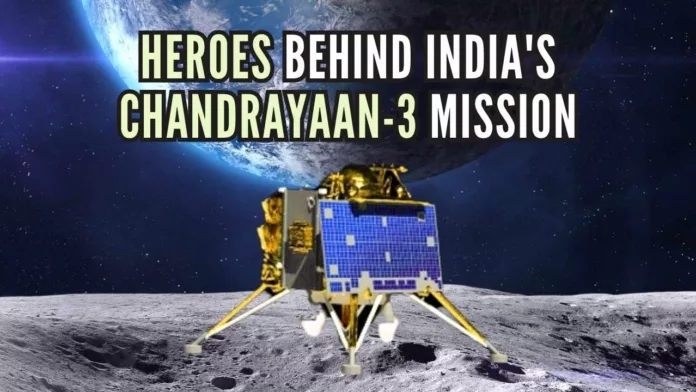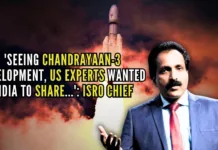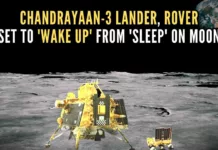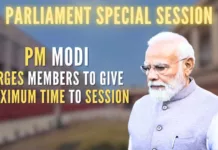
Chandrayaan-3: Meet the heroes behind India’s historic moon mission
The heroes behind India’s gigantic leap into space – The Chandrayaan-3 mission were confident of soft landing the country’s moon lander on the lunar soil, a ‘Mission Possible‘ after the failure of Chandrayaan-2.
In Chandrayaan-3, the Mission Director was Mohan Kumar and the Vehicle/ Rocket Director was Biju C Thomas.
“There are about 54 female engineers/ scientists who worked directly in the Chandrayaan-3 mission. They are associate and deputy project directors and project managers of various systems working at different centres,” a senior official of the Indian Space Research Organisation (ISRO) said preferring anonymity.
Well, the Men in Chandrayaan-3 are as follows:
Dr. S Somanath, Chairman, ISRO.
Most of the Hindu names signify a God. In the case of S Somanath, Chairman, the Indian Space Research Organization (ISRO), the name means Master of the Moon.
Incidentally, it was his responsibility to see India’s moon lander soft land successfully on Wednesday evening.
As a young engineer, Somanath dared to set right an anomaly along with two of his seniors in a Polar Satellite Launch Vehicle (PSLV) that was ready for takeoff.
Normally in such a situation, the rocket launch would have been postponed, draining the fuel and other laborious processes. The other option was trying to set the problem right when the rocket is fueled up a risky proposition.
However, the three brave officials including the young Somanath set right the problem. The rocket lifted off safely and made the mission a success.
Nearly two decades later, as the head of ISRO, Somanath seems to have set right the issues that resulted in the crash landing of India’s first moon lander called Vikram.
Son of a Hindi teacher, Somanath was interested in science. Later he pursued a B.Tech in Mechanical Engineering but had an active interest in rocketry.
Like a dream come true, in 1985 Somanath got a job with ISRO and joined the Vikram Sarabhai Space Centre (VSSC) in Thiruvananthapuram, which was responsible for rockets.
Somanath took his B. Tech in Mechanical Engineering from TKM College of Engineering, Kollam, and Masters in Aerospace Engineering from the Indian Institute of Science, Bangalore with specialization in Structures, Dynamics, and Control.
Rising up the ranks, he joined the GSLV MkIII Project during 2003 and was the Deputy Project Director responsible for the overall design and integration of India’s heaviest and most powerful rocket. He was the Project Director of GSLV Mk-III (now LVM-3) from June 2010 to 2014.
Somanath also led the team of LPSC (ISRO’s Liquid Propulsion Systems Centre) to complete the development and qualification of the CE20 cryogenic engine and the C25 stage, which was successfully flown in the GSLV MkIII-D1 flight.
Prior to becoming ISRO Chairman, Somanath headed VSSC as its Director.
Dr. S Unnikrishnan Nair, Director, Vikram Sarabhai Space Centre.
He is a Distinguished Scientist heading the Vikram Sarabhai Space Centre (VSSC) – India’s rocket centre – as well as a Malayalam short story writer.
Dr. S Unnikrishnan is a B.Tech in Mechanical Engineering from Kerala University, an ME in Aerospace engineering from the Indian Institute of Science, Bengaluru, and a doctorate in Mechanical Engineering from the Indian Institute of Technology-Madras.
Apart, he also holds an MA in Telecommunications and Space Law from NALSAR, Hyderabad.
Unnikrishan began his career in VSSC in 1985 and was involved in the development of various aerospace systems and mechanisms for Indian rockets – PSLV, GSLV, and LVM3.
He played a key role in the maiden orbital re-entry experiment, the Space Capsule Recovery Experiment (SRE), right from the study phase onwards to its mission accomplishment in 2007.
He was associated with the Human Spaceflight Programme from its study phase since 2004 and was the Project Director for Pre-project technology development activities.
Unnikrishnan led the project team in defining the Vehicle configuration and systems engineering and in identifying various critical technology development areas to initiate the pre-project activities.
As founding Director of the youngest Centre in ISRO, the Human Space Flight Centre (HSFC) Unnikrishnan has led the team for the Gaganyaan Project and established the Astronaut Training Centre at Bangalore in HSFC at Bangalore.
Dr. P Veeramuthuvel, Project Director, Chandrayaan-3.
Son of a railway employee, Dr. P Veeramuthuvel always aimed for the skies. Hailing from Tamil Nadu’s Villupuram district, Veeramuthuvel completed his Diploma in Mechanical Engineering and went on to get a Degree in Engineering. Later he did his PhD at IIT-Madras. He joined ISRO in 2014.
M Shankaran, Director, U R Rao Satellite Centre.
A Distinguished Scientist M Shankaran took over as Director of U R Rao Satellite Centre (URSC), the lead Centre in the country for the design, development, and realisation of all satellites of ISRO, on June 1, 2021.
He is currently leading the satellite fraternity to realize various types of satellites to meet the national requirements in areas like communication, navigation, remote sensing, meteorology, and inter-planetary exploration.
During his 35 years of experience in URSC/ ISRO, he has contributed primarily in the areas of Solar arrays, Power systems, Satellite Positioning Systems, and RF communication systems for Low Earth Orbit (LEO) Satellites, Geostationary Satellites, Navigation Satellites, and Outer Space Missions like Chandrayaan, Mars Orbiter Mission (MOM) and others.
He is now leading the efforts for the miniaturization of avionics systems, indigenization of electronics & power system components, micro/mini satellite bus development, and others. He is also spearheading the avionics system design, realization, and qualification for the Gaganyaan Programme.
He joined the ISRO Satellite Centre (ISAC), currently known as URSC after obtaining his Master’s degree in Physics from Bharathidasan University, Tiruchirappalli in 1986.
Dr. V Narayanan, Director, Liquid Propulsion Systems Centre.
He is the man providing the propulsion power to Indian rockets. Dr V Narayanan, an Alumni of Indian Institute of Technology- Kharagpur has taken his M.Tech with First Rank in Cryogenic Engineering in 1989 and Ph.D in Aerospace Engineering in 2001.
A rocket propulsion expert Narayanan joined ISRO in 1984 and functioned in various capacities before becoming Director of the Centre. As Project Director for the C25 Cryogenic Project, he led the team and successfully developed the C25 Cryogenic Stage.
When India was denied the complex Cryogenic Propulsion Technology for the GSLV Mk-II vehicle, Narayanan played a crucial role in the successful development of the Cryogenic Upper Stage (CUS) and contributed in making it operational for the GSLV Mk II vehicle.
He has guided the team and designed a 200-tonne thrust Lox-Kerosene Semi Cryogenic Rocket Engine.
During the initial period from 1984 to 1988 in ISRO, he also contributed to the Solid Propulsion System realization for launch vehicles. As Associate Director of LPSC, he guided the liquid propulsion activities of ISRO and was instrumental in finalizing the Liquid Propulsion Roadmap of ISRO for the next 20 years.
A Rajarajan, Director, Satish Dhawan Space Centre.
He first joined India’s rocket centre – Vikram Sarabhai Space Centre (VSSC) and over the years rising through the ranks and is now heading the Satish Dhawan Space Centre (SDSC) that provides the solid fuel for the rocket and also the country’s rocket port in Sriharikota in Andhra Pradesh.
A Mechanical Engineer, Rajarajan joined VSSC’s Fiber Reinforced Plastics Division and over the years grew within the organization and assumed additional challenges.
[With Inputs from IANS]
PGurus is now on Telegram. Click here to join our channel and stay updated with all the latest news and views
For all the latest updates, download PGurus App.
- BJP drops 2-term sitting MP Poonam Mahajan; fields 26/11 counsel Ujjwal Nikam from Mumbai North Central - April 27, 2024
- RBI sets criteria for Small Finance Banks seeking Universal Banks license - April 27, 2024
- 16 Indian crew members on seized cargo ship to be released soon: Iran Foreign Minister - April 27, 2024











My head is held high, My pride at its peak – thanks to ISRO
India’s / Bharat’s Kundalini is awakened with this achievement….. now it will up all balance 6 chakras to reach Sahasra…
Bharat will set the pace for the world.
Hope Pappu will volunteer for the Gaganyan mission
Humor
I was always connected with ISRO since my school days.
Teacher hamesha bolti thi tum “USRO” me mat baitho tum “ISRO” me baitho 😀
None from Yogi Adityanath’s state. Nor Modi’s.